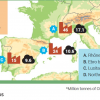
On the eve of its second year, the EU-funded STRATEGY CCUS project has selected three of its eight “promising” regions in southern and eastern Europe to now benefit from detailed carbon capture, usage and storage (CCUS) roadmaps.
After a challenging decision, project partners and external advisers chose the Rhône Valley in France, Spain’s Ebro basin and the Lusitanian basin in Portugal as having the most potential for large-scale deployment of the climate technology.
CCUS is widely accepted as a key part of efforts to meet Paris Agreement targets, with the potential to significantly reduce emissions from Europe’s industrial and power sectors.
The three selected regions will now be the focus of in-depth life cycle analysis (LCA) [1] and techno-economic analysis (TEA) [2] over the next 12 months.
In keeping with its aim to support a low-carbon transition in eastern as well as southern Europe, the project partners have reallocated funding to provide detailed economic modelling and a CCUS roadmap for Northern Croatia, which came fourth in the vote.
The voting process was based on a set of criteria for each region, including the existence of industry clusters, CO2 transport and geological CO2 storage options, and opportunities for CO2 usage.
The other four regions in France, Greece, Poland and Romania – part of an initial group identified as promising for CCUS development – will be the subject of less intense studies as STRATEGY CCUS moves to its next phase of work. These results for all eight regions, due in early 2022, will feed into CCUS deployment scenarios for 10, 20 and 30-year timescales.
The resulting roadmaps, which will include business models, technical knowledge and best practice on issues, such as social acceptance, aim to show national and regional governments and business that CCUS is both feasible and essential for meeting Paris Agreement pledges on climate action.
Dr Isabelle Czernichowski-Lauriol, of France’s BRGM and Project Director, said: “We are very excited to be moving to this next phase of our project. Our intention is to provide southern and eastern European governments and citizens with an overview of CCUS development feasibility in their areas, in close connection with a wide range of local socio-economic activities. We aim to help territories achieve carbon neutrality with feasible roadmaps for the short, medium and longer term.”
Barbara Olfe Krautlein of IASS Potsdam and member of the project’s Advisory Board, said: “The success of CCUS strategies depends on local conditions to a large extent. Next to technical and structural criteria, this includes different societal aspects. Partly, they can be assessed in techno-economic and in life-cycle assessments. But to gain insights and knowledge about acceptance aspects in a specific region, it is of great importance to include concerned stakeholders as early as possible. The stakeholder work in the STRATEGY CCUS project will ensure the future viability of the developed technological options.”
Nicolas Peugniez of GRT Gaz and adviser on the project’s Industry Club, said: “The STRATEGY CCUS project definitely addresses both an issue, CCUS, and geographical areas, southern and eastern Europe, which need to be explored if we want to address CO2 emissions from industry. All eight regions have their own strengths and progress points, and several would benefit from being studied together to check for synergies. CCUS needs teamwork of European scale and STRATEGY CCUS contributes to this purpose.”
[1] Life-cycle analysis (LCA) will assess the environmental impacts of CCUS deployment from development stages through to full-scale operations, including emissions, embodied energy and resource use.
[2] Techno-economic analysis (TEA) will consider technology options, availability and cost alongside a comprehensive diagnosis of potential local business models associated with different CCUS options.
[3] The regions selected for more in-depth studies feature the industrial and geological zones below. Download our map infographic here.
- Rhône valley in France includes the Fos-Berre/Marseille CCU cluster targeted by the SET Plan Action 9 (as a Flagship Project), and Lyon metropole.
- Ebro basin in Spain features the Tarragona industrial area and the North Castellón and North Teruel areas.
- Lusitanian basin in Portugal includes CO2 sources in the Leiria-Figueira da Foz axis and extends to the Lisbon industrial region.
- Northern Croatia includes Zagreb and the Croatian part of Pannonian basin.
[4] The STRATEGY CCUS project – Strategic planning of Regions and Territories in Europe for low-carbon energy and industry through CCUS Coordination and Support Action – is led by BRGM, the French geological survey, and is a collaboration of 17 science and industry partners from 10 European countries (France, Spain, Portugal, Greece, Croatia, UK, Romania, Poland, Germany, Norway). It has received funding from the European Union’s Horizon 2020 research and innovation programme under grant agreement No 837754. It began in 2019 and runs until 2022.




